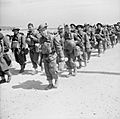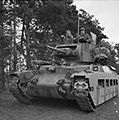Battle of France facts for kids
Quick facts for kids Battle of France |
|||||||
|---|---|---|---|---|---|---|---|
| Part of World War II | |||||||
 British and French soldiers taken prisoner in Northern France. |
|||||||
|
|||||||
| Belligerents | |||||||
| Axis: |
Allies: |
||||||
| Commanders and leaders | |||||||
(Army Group A) (Army Group B) (Army Group C) (Army Group West) |
(British Expeditionary Force) |
||||||
| Strength | |||||||
| Germany: 141 divisions 7,378 guns 2,445 tanks 5,638 aircraft 3,350,000 troops Alps on 20 June 300,000 Italians |
144 divisions 13,974 guns 3,383 tanks 2,935 aircraft 3,300,000 troops Alps on 20 June ~150,000 French |
||||||
| Casualties and losses | |||||||
| Germany: 28,225 dead (possibly as high as 49,000) 113,152 wounded 13, 307 missing 1,290 aircraft lost (10 May to 24 June 1940) 1,097 aircrew killed, 1395 injured, 1930 missing 795 tanks Italy: 1,247 dead or missing, 2,631 wounded, 2,151 hospitalised due to frostbite1 |
360,000 dead or wounded, 1,900,000 captured 1029 RAF aircraft, 1274 french aircraft |
||||||
| 1 Italian forces were involved in fighting in the French Alps, where severe sub-zero temperatures are common, even during the summer. | |||||||
In World War II, the Battle of France, also known as the Fall of France, was when Germany invaded France and the Low Countries (like Belgium and the Netherlands). This major battle happened from May 10 to June 25, 1940. It marked the end of a quiet period in the war called the "Phoney War." Germany won this battle very quickly and decisively.
Contents
The Battle of France: A Quick Victory
The Battle of France was a key part of World War II. It showed how fast and powerful Germany's army had become. The invasion surprised many, as Germany used new tactics to defeat the Allied forces quickly.
What Was the Battle of France?
The Battle of France was the German invasion of France and nearby countries. These countries included Belgium, the Netherlands, and Luxembourg. The battle lasted about six weeks in the spring of 1940. It was a huge victory for the Axis powers, especially Germany.
The main countries involved were:
- Axis Powers: Germany and, later, Italy.
- Allies: France, the United Kingdom, Belgium, the Netherlands, Canada, Poland, Czechoslovakia, and Luxembourg.
Germany used a new military strategy called Blitzkrieg, which means "lightning war." This strategy involved fast-moving tanks and air support. It allowed them to break through enemy lines quickly.
Two Main Parts of the Battle
The Battle of France had two main phases:
Phase 1: Case Yellow (Fall Gelb)
The first part was called Fall Gelb (Case Yellow). It started on May 10, 1940. German tank units pushed through the Ardennes forest. This was a hilly, wooded area that the Allies thought was too difficult for tanks. This surprise attack aimed to surround Allied units that had moved into Belgium.
Many British and French soldiers found themselves trapped. They were pushed back to the coast at Dunkirk. A huge rescue mission, called Operation Dynamo, took place. Over 330,000 soldiers were evacuated by sea to England. This saved many lives, but a lot of equipment was left behind.
Phase 2: Case Red (Fall Rot)
The second part, called Fall Rot (Case Red), began on June 5. German forces then moved to attack the rest of France. They went around the strong French defenses known as the Maginot Line. This line was a series of forts and bunkers built along France's border with Germany.
On June 10, Italy also invaded southeastern France. The French government left Paris and moved to Bordeaux. German troops marched into Paris on June 14. France's Second Army Group surrendered on June 22. Finally, France officially gave up on June 25, 1940.
After the Battle
After France surrendered, it was divided into different parts:
- A large part of northern and western France was occupied by Germany.
- A small area in the southeast was occupied by Italy.
- The southern part of France became a satellite state called Vichy France. This government worked with Germany.
In November 1942, Germany took full control of southern France. France remained under German control until the Allied return in 1944. The Low Countries were set free in 1944 and 1945.
Related pages
Images for kids
-
The classic characteristic of what is commonly known as "blitzkrieg" is a highly mobile form of infantry and armour, working in combined arms. (German armed forces, June 1942)
-
Men of the 1st Royal Welch Fusiliers fire Boys anti-tank rifles near Etaples, February 1940
-
Curtiss H-75A1 of the 3rd flight of Groupe de Chasse II/5 Armée de l'Air, June 1940
-
Winston Churchill visited France several times during the battle in an attempt to help bolster French morale
-
Calais in ruins
-
British and French troops evacuated from Dunkirk arrive at Dover.
-
The German offensive to the Seine River between 4 and 12 June
-
War refugees on a French road
-
British troops on their way to Brest, June 1940 -
On 21 June 1940, near Compiègne in France, Hitler (hand on hip) staring at Marshal Foch's statue before starting the negotiations for the armistice, to be signed the next day by Keitel, Hitler being absent. The Glade of the Armistice was soon destroyed together with all commemorative monuments (except Foch's statue) by the Germans.
-
Hitler tours Paris with architect Albert Speer (left) and sculptor Arno Breker (right), 23 June 1940
See also
 In Spanish: Batalla de Francia para niños
In Spanish: Batalla de Francia para niños



























